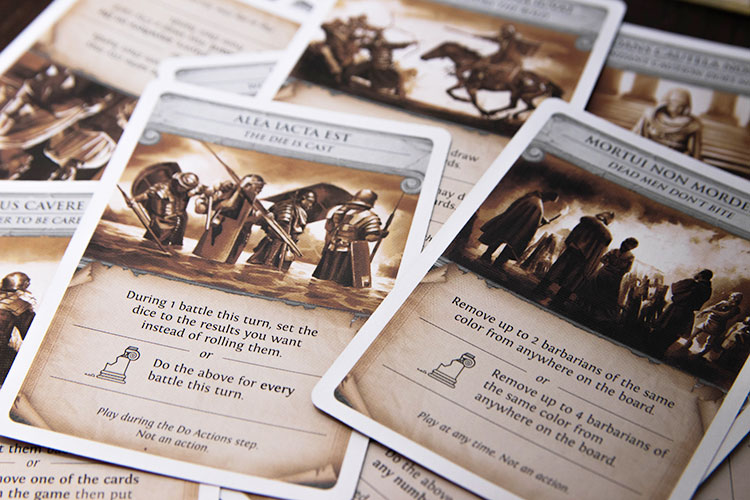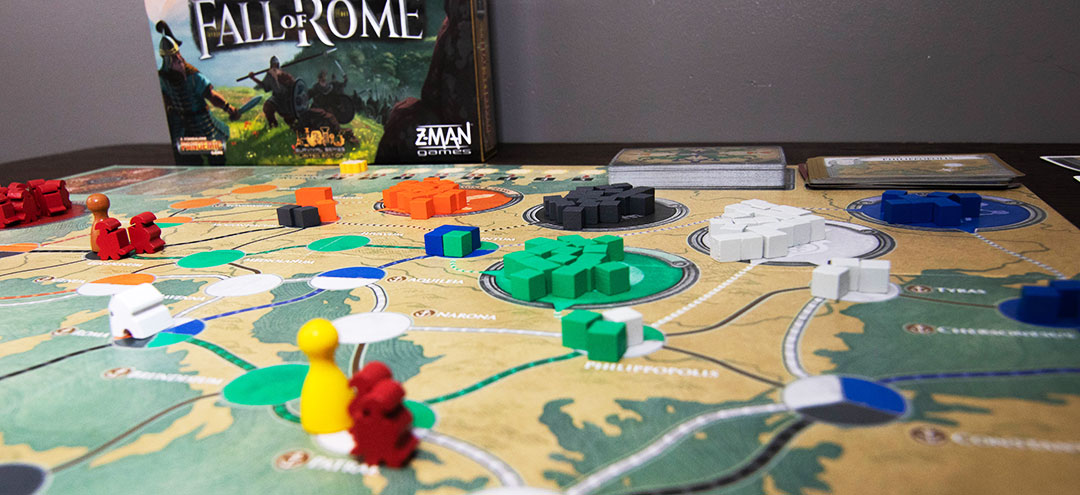 Saying something is “inarguably” true on the internet is really just asking for trouble. But, regardless, Pandemic is inarguably one of the most popular modern board games in existence. Not only did it spawn two hugely successful legacy games (which, in turn, caused an explosion of other legacy games) it also has a variety of spin-offs using a take on the Pandemic formula.
Saying something is “inarguably” true on the internet is really just asking for trouble. But, regardless, Pandemic is inarguably one of the most popular modern board games in existence. Not only did it spawn two hugely successful legacy games (which, in turn, caused an explosion of other legacy games) it also has a variety of spin-offs using a take on the Pandemic formula.
Today we are looking at Pandemic: Fall of Rome to see what it brings new to the table for your Pandemic experience. (Spoiler alert: it’s dice!)
Pandemic: Fall of Rome is a cooperation action selection game for 1-5 players. It plays in about an hour and works best with 3 (or 4 really fast) players as it can slow down a bit with a full table.
Gameplay Overview:
For our overview we are going to look mostly at what makes Fall of Rome different from the other incarnations of Pandemic. You will still spend your turn taking four actions and then drawing cards that add bad things to the map. This time, rather than diseases, you’ll be adding barbarians throughout the Roman Empire.

However, you won’t always add the barbarian cubes to the city that you have drawn, as the enemies have to slowly march their way toward Rome. If you draw a card that already has a barbarian in it or is adjacent to a city with a barbarian, you’ll add another to that city. Otherwise, you’ll work backwards from Rome along that tribe’s particular migration path, until you get to the next city in between them and Rome and add it there.
If you ever need to add a fourth barbarian, you’ll have an outbreak—ehm, I mean, the city will be sacked, causing all adjacent cities to have a barbarian from that tribe added. Each sacked city increased the decline marker on its track; one of the many ways you can lose the game. You aren’t defenseless, however. One of the available actions for you is to recruit legions to help defend the Roman empire. If you have legions in a city when a barbarian would be added, they will defend the city, preventing the barbarian incursion.
The legions are also necessary for attacking the pesky barbarian invaders. Players have the ability to battle against the barbarians, rolling dice equal to the number of legions in the city (max 3) and removing barbarians and/or legions based on the results of the roll.
You can forge alliances with the tribes in Fall of Rome, which is akin to curing the diseases in traditional Pandemic. However, unlike regular Pandemic, you don’t have to ally with all the tribes to win. If at any point there are no non-allied barbarian tribes on the map, the players win. So you can ally with some and just wipe out others in whatever mix works out best.

Game Experience:
Fall of Rome succeeds wonderfully in both feeling familiar and fresh. The twists on the gameplay are significant, but anyone who has played Pandemic will feel at home with what they are trying to accomplish. And overall it provides a great experience with some interesting player powers and added variance with the die-rolling mechanism.

The biggest departure is the migration path that each tribe must follow on its way toward Rome. The game’s five tribes start in various areas, but generally all descend from the northern section of the map southward toward Rome. This gives you some extra things to keep in mind when planning your actions as groups will progress relatively slowly and not pop up scattered around all corners of the map.
This gives you the ability to use your legions wisely, positioning them along the barbarian’s path to defend the cities to prevent barbarians from being added. Anytime a legion is present in the city when a barbarian would be added, it’s prevented. However, if you have multiple legions in that city, they are all removed when that happens, unless they are supported by a player’s pawn or a fort (i.e., research station) in that city.

And finally, not every tribe is created equal in Fall of Rome. The Ostrogoths, for instance, only require three cards to ally with, making them by far the easiest tribe to make nice with. But they only have 14 barbarian cubes in their supply. If you ever need to add a cube of any tribe and their supply is empty, you lose, so you have to keep them in check or forge that alliance quickly. The Visigoths, meanwhile, have 24 cubes but require 5 cards of their color to make an alliance with. Making them a likely target for wiping off the map rather than collecting all the cards to satisfy them.
There is just way more to consider in Fall of Rome that outside of the normal number-crunching odds game you get from its disease-curing brethren. Even the event cards have an additional choice, giving you a stronger ability at the cost of some stability. It’s easier to play by feel than calculating the percentage of every possible outcome and making the “smart” play. And of course, the dice don’t care how well you’ve planned. You will find yourself having some very important die rolls throughout the game which makes for some tense moments.

Final Thoughts:
Pandemic: Fall of Rome takes full advantage of the Roman Empire setting to create a fun and immersive co-op experience. Despite the Pandemic name on the front of the box, it feels very much like a tactical battle between the players and the game itself. Thematically the migration, the legions, and the battles makes the theme “pop” more than any other past Pandemic game.
If you are a fan of the Pandemic games, Pandemic: Fall of Rome is one of my favorites and I suggest you check it out. There is certainly room in a collection for Fall of Rome alongside the others in the series.
Final Score: 4.5 Stars – Another great entry into the Pandemic series. Makes great use of the theme and setting.
 Hits:
Hits:
• Best use of theme in a Pandemic game to date.
• Interesting and different character roles.
• Feels different from other games in the Pandemic line.
Misses:
• Drags at the higher player counts and prone to quarterbacking.
























Hi, I would like to make a question because I have played three times so far and won twice, so I’m wondering if I have misunderstood the following rule…
I have shuffled the 9 gold-bordered cards and have added 3 white cubes in two cities. The first play of the players is to remove the 3 white cubes so as to eliminate the white tribe. Do I need to place white cubes from now on? Have I already won this tribe and must forge an alliance with the remaining ones? Is it correct or I have to continue placing white cubes until to forge an alliance with the white tribe too?
I won twice by eliminating the smaller amount of cubes during the first 2–3 player moves which means that a whole tribe has been eliminated from the very first moves of the games.